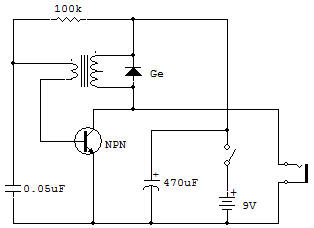

Capacitive Charge Oscillator

This project demonstrates how an oscillator can be made to operate a long time by the energy stored in a Capacitor. It also uses a different type of oscillator circuit from what you have been using.
After the switch is opened, the circuit continues to oscillate for about a minute. One reason for such a long time is that the oscillator has a very short "duty cycle". The duty cycle is a measure of comparison between the time a circuit is conducting and the total time to complete one cycle.
This circuit, like most pulse and blocking oscillators, conducts for less than half of the total time the circuit is ON. In fact, 10 to 15 percent of the time is all that is used for the ON time in this circuit.
This circuit has both the requirements of an oscillator. That is, gain greater than 1 (the output is greater than the input), and regenerative feedback to sustain oscillations. The Transistor provides a gain much greater than 1 (1 stands for the value of the input).
The Transformer provides regenerative feedback with proper polarization of the windings. The 100K Resistor initially supplies base-bias current to the 2SC to begin oscillations, but once oscillations begin it provides a discharge path for the 0.05uF Capacitor during the Transistor OFF times.
During the ON times the Capacitor is charged and the Transistor held on by the induced voltage from the Transformer base winding.
The germanium (Ge) Diode shorts out the Transformer at the instant the current stops flowing through the Transformer as the Transistor is turned OFF. This protects the Transistor from this potentially destructive spike of energy.
The Diode circulates the current back around the Transformer winding so that no harm is done. During all other parts of the oscillation cycle, the Diode receives either reverse bias voltage or zero voltage so that it acts like an open circuit.
Remember, in all semiconductor devices current can only flow against the arrow head symbol.
